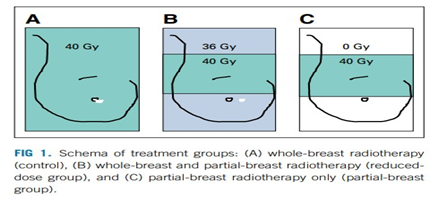(구)글로벌 핫이슈
방사선종양학
- [J Clin Oncol.] 전유방 or 부분유방 방사선치료 5년 이후 환자 보고 결과: IMPORT LOW (CRUK/06/003) 3상 무작위 임상연구 분석 Patient-Reported Outcomes Over 5 Years After Whole- or Partial-Breast Radiotherapy: Longitudinal Analysis of the IMPORT LOW (CRUK/06/003) Phase III Randomized Controlled Trial.
Cambridge University / Charlotte E. Coles*
- 출처
- J Clin Oncol.
- 등재일
- 2019 Feb 1
- 저널이슈번호
- 37(4):305-317. doi: 10.1200/JCO.18.00982. Epub 2018 Dec 11.
- 내용

Abstract
PURPOSE:
IMPORT LOW demonstrated noninferiority of partial-breast and reduced-dose radiotherapy versus whole-breast radiotherapy for local relapse and similar or reduced toxicity at 5 years. Comprehensive patient-reported outcome measures collected at serial time points are now reported.PATIENTS AND METHODS:
IMPORT LOW recruited women with low-risk breast cancer after breast-conserving surgery. Patients were randomly assigned to 40 Gy whole-breast radiotherapy (control), 36 Gy whole-breast and 40 Gy partial-breast radiotherapy (reduced-dose), or 40 Gy partial-breast radiotherapy only (partial-breast) in 15 fractions. European Organisation for Research and Treatment of Cancer Quality of Life Questionnaires Core 30 and Breast Cancer-Specific Module, Body Image Scale, protocol-specific items, and the Hospital Anxiety and Depression Scale were administered at baseline, 6 months, and 1, 2, and 5 years. Patterns of moderate/marked adverse effects (AEs) were assessed using longitudinal regression models, and baseline predictors were investigated.RESULTS:
A total of 41 of 71 centers participated in the patient-reported outcome measures substudy; 1,265 (95%) of 1,333 patients consented, and 557 (58%) of 962 reported no moderate/marked AEs at 5 years. Breast appearance change was most prevalent and persisted over time (approximately 20% at each time point). Prevalence of breast hardness, pain, oversensitivity, edema, and skin changes reduced over time ( P < .001 for each), whereas breast shrinkage increased ( P < .001). Analysis by treatment group showed average number of AEs per person was lower in partial-breast (incidence rate ratio, 0.77; 95% CI, 0.71 to 0.84; P < .001) and reduced-dose (incidence rate ratio, 0.83; 95% CI, 0.76 to 0.90; P < .001) versus whole-breast group and decreased over time in all groups. Younger age, larger breast size/surgical deficit, lymph node positivity, and higher levels of anxiety/depression were baseline predictors of subsequent AE reporting.CONCLUSION:
Most AEs reduced over time, with fewer AEs in the partial-breast and reduced-dose groups. Baseline predictors for AE reporting were identified. These findings will facilitate informed discussion and shared decision making for future patients receiving moderately hypofractionated breast radiotherapy.
Author informationBhattacharya IS1, Haviland JS1, Kirby AM1,2, Kirwan CC3, Hopwood P1, Yarnold JR1, Bliss JM1, Coles CE4; IMPORT Trialists.
1
The Institute of Cancer Research, London, United Kingdom.
2
Royal Marsden National Health Service Foundation Trust, London, United Kingdom.
3
University of Manchester and University Hospital of South Manchester, Manchester, United Kingdom.
4
Cambridge University, Cambridge, United Kingdom.
- 덧글달기









